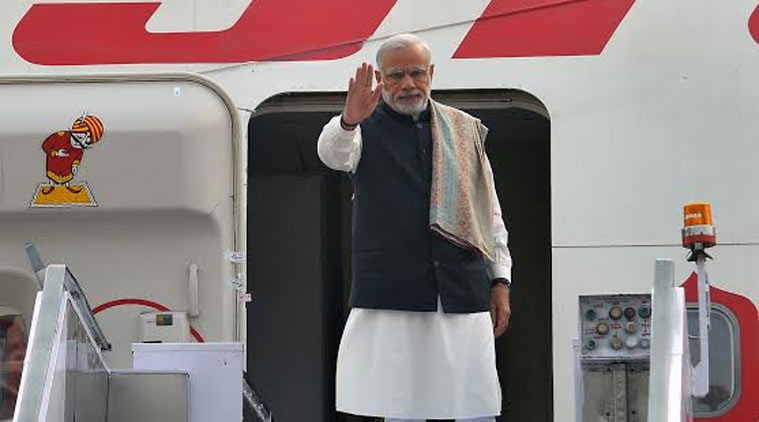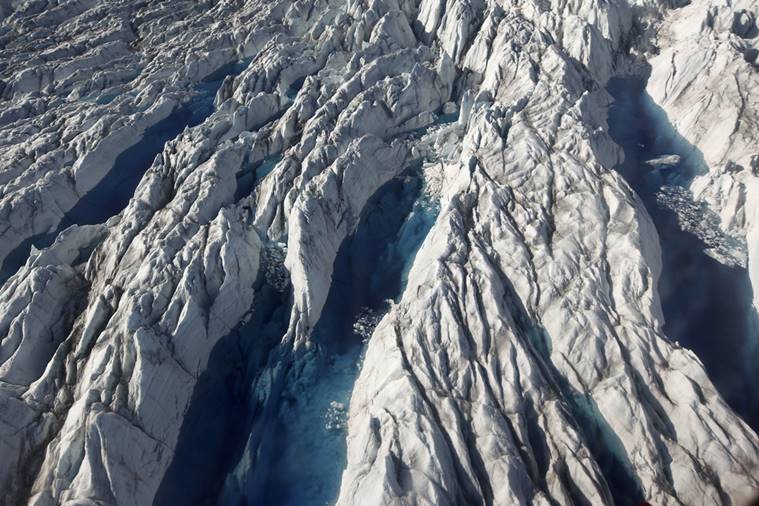Stay updated with the latest - Click here to follow us on Instagram
At world table today, PM will underline: Climate is responsibility, concern of all
Modi will formally open the India pavilion which has impressed everyone — it is the first time India has put up a pavilion at this annual conference to showcase its philosophy and approach towards climate change.
 PM Narendra Modi leaves New Delhi to join world leaders in Paris.
PM Narendra Modi leaves New Delhi to join world leaders in Paris.
A smartly done India pavilion at the venue of the climate change conference in Paris was grabbing eyeballs, bringing a smile on faces of negotiators and campaigners who started gathering in the French capital for two weeks of tense negotiations at one of the most keenly-awaited meetings in recent times.
The conference formally began in the evening Sunday, a day earlier than the usual Monday start, but only for logistical and procedural discussions. Monday is the big day when close to 150 heads of states and governments, including India’s Narendra Modi, will make three-minute speeches each, offering their political support to the negotiations that are expected to deliver a landmark global agreement on climate change.
Also read: Barack Obama to meet PM Modi today
Modi landed in Paris Sunday night after talking to the nation on climate change through his Mann ki Baat radio programme. His role in Paris is not just confined to making the three-minute appeal. Modi will launch the Global Solar Alliance, an effort to bring together tropical countries to promote solar energy, in a separate event for which at least 30 heads of states have signed up to attend, Indian officials said.
“The entire world is worried about climate change, global warming, and it is being debated and discussed everywhere. This is everyone’s responsibility and also concern,” Modi said in his radio broadcast.
A book whose preface has been written jointly by him and French President Francois Hollande will also be launched and distributed to all visiting delegates. The book contains excerpts of writings and thoughts of famous Indian and French philosophers on the need to maintain harmony with nature.
Also read: Earth is a wilder, warmer place since last climate deal
Modi will formally open the India pavilion which has impressed everyone — it is the first time India has put up a pavilion at this annual conference to showcase its philosophy and approach towards climate change. A falling water fountain that made patterns of words and built messages like ‘Just Climate Action’, and ‘Kochi, first green airport of the world’, chic audio visuals on circular walls that acted as screens, and lots of digital information about India’s climate programme forced every passer-by to stop, acknowledge and appreciate.
But the main excitement Sunday was outside the conference venue, not just in Paris but in hundreds of other cities across the world, including Delhi and Bangalore. Coordinated protest marches were organised by several NGOs demanding greater action on climate change and tougher restrictions on the bigger emitters. At one event in Paris outside a railway station, police had to fire teargas shells to disperse the crowd.
That was the only ripple caused by law enforcement agencies in Paris which hardly looks a city hosting such a major global event barely three weeks after a terrorist attack that killed over 100 people. There are no barricades to be seen anywhere, no additional security checks and no posse of policemen guarding the streets. In fact, the French government made all public transport in Paris free for everyone, thereby lifting that small restriction of controlled access to railway stations.
 In this file photo, pools of melted ice form atop Jakobshavn Glacier, near the edge of the vast Greenland ice sheet. Since 1997, the West Antarctic and Greenland ice sheets have lost 5.5 trillion tons of ice (5 trillion metric tons), according to Andrew Shepherd at the University of Leeds, who used NASA and European satellite data. (AP Photo/Brennan Linsley, File)
In this file photo, pools of melted ice form atop Jakobshavn Glacier, near the edge of the vast Greenland ice sheet. Since 1997, the West Antarctic and Greenland ice sheets have lost 5.5 trillion tons of ice (5 trillion metric tons), according to Andrew Shepherd at the University of Leeds, who used NASA and European satellite data. (AP Photo/Brennan Linsley, File)







